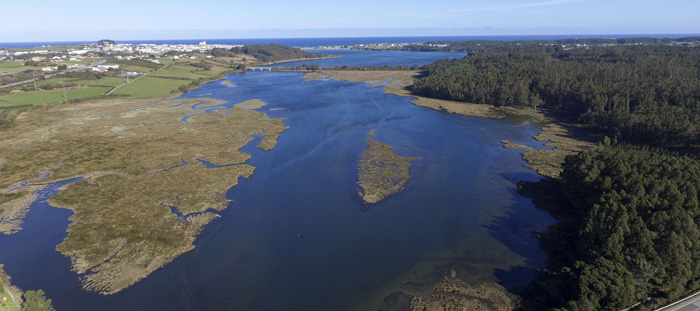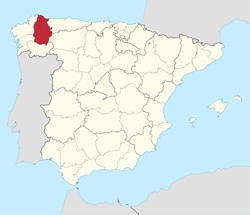Lugo in Lugo

The largest of the four provinces that constitute the autonomous region of Galicia, Lugo is nonetheless penultimate when it comes to inhabitants. Covering an area of 9,856 km2 it has a population of only 331,327 which gives it a population density of 33.61 inhabitants per km2, which is only about a third of the national average.
The province of Lugo lies in north western Spain and borders on the Cantabrian Sea, the provinces of A Coruña, Pontevedra, Orense and Leon, and the Principality of Asturias.
The highest point in the province is Mustellar in the Sierra de Ancares. It reaches 1,935 MASL and is situated on the border with the province of Leon.
The province boasts stunning countryside and a host of small, historic villages, each with their own unique past and many quaint buildings.
The coastline of Lugo, which is constantly battered by the Atlantic Ocean, is rugged and wild, and on the Playa das Catedrais (Beach of Cathedrals) enormous and amazing rock formations, carved out by the wild sea, greet the many visitors to the spot, where you can really appreciate the size of the formations when the tide is out.
The capital of the province of Lugo is Lugo, where 98,025 (2018) ‘Lucenses’ (people from Lugo) have their home. Although the province of Lugo is very much a ‘sea province’, its capital is situated at 85 km from the sea. It is sat on top of a hill in a region of low, rounded mountains and it is encircled by the river Miño.
 The centre of the city is 455 MASL, but the altitude of the city varies between 355 MASL down by the river, and 783 MASL at the Monte de Meda in the south western part of the city.
The centre of the city is 455 MASL, but the altitude of the city varies between 355 MASL down by the river, and 783 MASL at the Monte de Meda in the south western part of the city.
Lugo capital is Galicia’s oldest city. It was founded by the Roman Paolo Fabio Maximo in 25 B.C., near an old fortified village.
There are numerous Roman remains to testify to this, many of them gathered in the Museo Provincial; and the unique Roman wall, which was proclaimed a World Heritage Site by the UNESCO in the year 2000, has been preserved in its entirety and surrounds the Old Quarter.
Both the city and the surrounding countryside are dominated by the Miño River and are within the ‘Terras de Miño’ biosphere, declared by the UNESCO in 2002. The fauna living by the river, even where it runs through the city, is extremely diverse, especially with regards to birds. The river is surrounded by parkland on its 30 km course through the city. Two other rivers, the Fervedoira and the Mera also run through the city, surrounded by parkland.
The Moors conquered the city in 714, and in history, Lugo stands out by having been reconquered by Alfonso Tin 741 and thus being only city in Christian Hispania during the 8th and the first half of the 9th centuries.
The economy of modern Lugo is mainly based on commerce and services. The university specialises in agricultural sciences, such as veterinary medicine and forestry, although it also offers a wide variety of other courses.
Apart from the Roman wall, other sights of interest in Lugo are the cathedral, Catedral deSanta Maria de Lugo, and the Plaza Mayor. A walk through the Old Quarter within the Roman wall is a must, and a stroll through the parks along the river makes for a relaxing afternoon.
Lugo’s two main fiestas are Arde Lucus and San Froilán. The former is celebrated at the end of June and commemorates the city’s Roman past; it was first celebrated in 2001 after the Roman wall became a World Heritage Site.
The other, San Froilán, goes from 4th to 12th October and is a mixture of religious and folklore festivities to celebrate Lugo’s patron saint. Hundreds of thousands of visitors crowd the city every year for this celebration which is the most important week of the year in Lugo.


